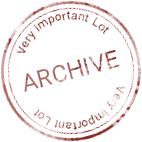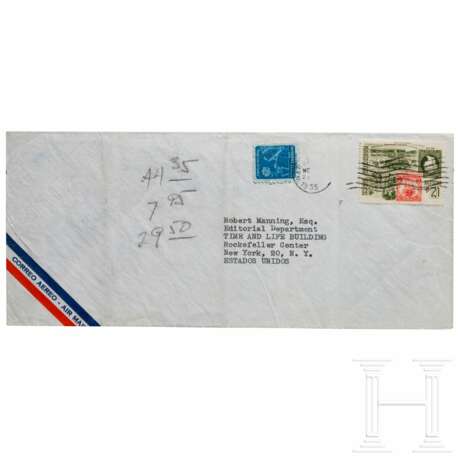Ernest Hemingway (1899 - 1961) - bedeutender, mit "Papa" signierter Brief an Robert Manning vom 30. Dezember 1954 mit Kuvert
07.05.2024 10:00UTC +02:00
Classic
Verkauft
4000EUR € 4 000
| Auctioneer | Hermann Historica |
|---|---|
| Veranstaltungsort | Deutschland, Grasbrunn / München |
| Aufgeld | 25 % |
Archiv
Die Auktion ist abgeschlossen. Es können keine Gebote mehr abgegeben werden.

ID 1196771
Los 4232 | Ernest Hemingway (1899 - 1961) - bedeutender, mit "Papa" signierter Brief an Robert Manning vom 30. Dezember 1954 mit Kuvert
Zwei Seiten dünnes Briefpapier mit rot gedrucktem Kopf "Finca Vigia, San Francisco de Paula, Cuba" und Wasserzeichen "Esleeck - Fidelity Onion Skin - Made in USA". Knapp anderthalb Seiten mit maschinenschriftlichem Text und vereinzelten Korrekturen Hemingways in Tinte, die zweite Seite in Tinte signiert "Papa". Je doppelt gefaltet.
Nach Robert Mannings Besuch Hemingways in Cuba 1954, bei dem der damalige Time-Reporter und spätere Herausgeber von "The Atlantic" (bis 2007 "The Atlantic Monthly") den Schriftsteller unmittelbar nach der Verleihung des Nobelpreises für Literatur interviewen durfte, dankt ihm Hemingway für einen Brief: "You were just as straight as you sounded on the phone when I decided you were trustworthy. It was a lot of fun fishing together and we were lucky that the fish were there". Zudem dankt er für Fotos und "the piece" (Anm.: das geführte Interview): "Bob I didn't mean I wouldn't read the piece. I meant for you to write anything you wished and I would not read it except to check direct quotes. Thought you handled the quote on Ezra (Anm.: der amerikanische Dichter Ezra Pound, 1885 - 1972) exceptionally well".
Hemingway möchte ein ihm vom Time Magazin geschenktes Porträt an Manning weitergeben: "A man keeping many portraits of himself around his house always makes a bad impression on me. Mary has that old days picture of me as Kid Balzac by Waldo Peirce that she likes and she has to look at my damned face every day".
Zudem nimmt Hemingway Stellung zur NBC-Radiosendung "Meet Ernest Hemingway" vom 19. Dezember 1954 mit Kritikern und Freunden Hemingways wie Sidney Franklin (1903 - 1976, US-Torero), Robert Manning (1919 - 2012), Max Eastman (1883 - 1969, sozialistischer US-Schriftsteller, seit seiner Reise in die Sowjetunion 1923 Freund von Leo Trotzki, ab 1941 Kritiker von Sozialismus und Kommunismus), Edward "Ted" Scott (neuseeländischer Journalist und Boxer, der Hemingway 1954 zu einem Duell mit .45er Pistolen herausforderte, nachdem Scott Hemingways Frau Mary nach einem Streit über Steaks aus Löwenfleisch beleidigt hatte, Hemingway verweigerte jedoch das Duell) oder Marlon Brando, der aus "The Old man and the Sea" vorlas.
Hemingway: "That night they had that NBC broadcast I tuned in around when Franklin was about half through bull shitting. There was a big electrical storm north of us and I could only hear whispers most of the time. [.] You sounded healthy and in good shape. Kamikaze Scott seemed very annoyed that I did not wish to kill him. I can't write books and kill people and go to jail to help their need for publicity. [.] Max Eastman was sort of comic too. [.] But that poor bastard has to always wake up in the morning remembering what really happened to him. On the other hand maybe he has convinced himself that his lie is true. For your own private information, I never travelled with Franklin's 'troupe'. That is all ball room bananas. I did pay for one of his operations though and tried to get him fights in Madrid when no promoter would have him [.] His version like Eastman's and Scott's makes them more comfortable. Maybe it is necessary to them. Franklin was a first rate novillero but was never worth a damn as a matador after the first time he was gored seriously. We were good friends for a long time and until I went to Mexico in 1940, I think, and saw with a bunch of fags I could not take and with his stories, that once were true and wonderful, all changed to delusions of grandeur. He'd forgotten the true ones and the ones he invented he published finally."
Er lädt Manning wieder nach Cuba ein: "Be a good boy, Bob, and come down here sometime when I'm through working and you don't have to write any piece and we will have fun. You were damned good company piece or no piece and I never saw anybody except a fighter pilot learn to fish so fast". Er schließt mit "Best wishes for a good New Year to you and your wife from Mary and me. Yours always", mit eigenhändiger Tintenunterschrift "Papa".
Dazu das "Correo Aereo - Air Mail"-Kuvert mit maschinenschriftlicher Adressierung "Robert Manning, Esq. - Editorial Department - TIME AND LIFE BUILDING - Rockefeller Center" in New York, rs. in Rot bedruckter Absender "Finca Vigia...", kubanische 12- bzw. 1-Cent-Briefmarken mit Poststempel aus Havanna wohl vom 2.1.1955.
Robert Manning veröffentlichte "the piece", sein mit Hemingway geführtes Interview, erst in der August-Ausgabe 1965 des Magazins "The Atlantic", dessen Executive Director er zu diesem Zeitpunkt war, auf den Seiten 101 bis 108. Nach der Wiedergabe des Interviews von 1954 zitiert Manning Hemingway auf Seite 108 wörtlich aus dem hier vorliegenden Brief im Zusammenhang mit der NBC-Radiosendung vom Dezember 1954, beispielsweise dessen Ansichten zu Sidney Franklin und Max Eastman.
Ein antiquarisches Exemplar des Magazins "The Atlantic" vom August 1965 in ordentlichem Zustand liegt bei. Bedeutender Brief eines der wichtigsten, erfolgreichsten und bekanntesten amerikanischen Schriftsteller.
Provenienz: Der NBC-Broadcast vom 19.12.1954 ist unter dem folgenden Link in voller Länge von knapp 54 Minuten und mit sämtlichen Beiträgen abspielbar: https://archive.org/details/BiographiesInSound/1954-12-19NbcBiographiesInSound01MeetErnestHemingway.mp3.
Ernest Hemingway (1899 - 1961) – an important letter to Robert Manning, signed "Papa" and dated 30 December 1954, with envelope
Ernest Hemingway (1899 - 1961) – an important letter to Robert Manning, signed "Papa" and dated 30 December 1954, with envelope
Two sheets of thin notepaper with the header printed in red "Finca Vigia, San Francisco de Paula, Cuba" and watermark "Esleeck - Fidelity Onion Skin - Made in USA". Almost one and a half pages of typewritten text with Hemingway's occasional corrections in ink, the second page signed "Papa" in ink. Both sheets folded twice.
After Robert Manning visited Hemingway in Cuba in 1954, when the Time reporter and later publisher of "The Atlantic" ("The Atlantic Monthly" until 2007) was allowed to interview the author immediately after being awarded the Nobel Prize in Literature, Hemingway thanks him for his letter: "You were just as straight as you sounded on the phone when I decided you were trustworthy. It was a lot of fun fishing together and we were lucky that the fish were there". In addition, he thanks him for photographs and "the piece" (note: the interview): "Bob I didn't mean I wouldn't read the piece. I meant for you to write anything you wished and I would not read it except to check direct quotes. Thought you handled the quote on Ezra (note: American poet Ezra Pound, 1885 - 1972) exceptionally well".
Hemingway wants to pass a portrait he was given by Time magazine onto Manning: "A man keeping many portraits of himself around his house always makes a bad impression on me. Mary has that old days picture of me as Kid Balzac by Waldo Pierce that she likes and she has to look at my damned face every day".
Moreover, Hemingway comments on the NBC radio programme "Meet Ernest Hemingway", broadcast on 19 December 1954, featuring critics and friends of Hemingway like Sidney Franklin (1903 - 1976, US bullfighter), Robert Manning (1919 - 2012), Max Eastman (1883 - 1969, a US socialist writer and friend of Leo Trotzki's since travelling to the Soviet Union in 1923, but a critic of socialism and communism from 1941), Edward "Ted" Scott (the New Zealand journalist and boxer who challenged Hemingway to a duel with .45 pistols in 1954, after Hemingway's wife Mary insulted Scott following a dispute about lion steaks. Hemingway refused to accept the challenge, however) and Marlon Brando, who read from "The Old Man and the Sea".
Hemingway writes: "That night they had that NBC broadcast I tuned in around when Franklin was about half through bull shitting. There was a big electrical storm north of us and I could only hear whispers most of the time. [.] You sounded healthy and in good shape. Kamikaze Scott seemed very annoyed that I did not wish to kill him. I can't write books and kill people and go to jail to help their need for publicity. [.] Max Eastman was sort of comic too. [.] But that poor bastard has to always wake up in the morning remembering what really happened to him. On the other hand maybe he has convinced himself that his lie is true. For your own private information, I never travelled with Franklin's 'troupe'. That is all ball room bananas. I did pay for one of his operations though and tried to get him fights in Madrid when no promoter would have him [.] His version like Eastman's and Scott's makes them more comfortable. Maybe it is necessary to them. Franklin was a first rate novillero but was never worth a damn as a matador after the first time he was gored seriously. We were good friends for a long time and until I went to Mexico in 1940, I think, and saw with a bunch of fags I could not take and with his stories, that once were true and wonderful, all changed to delusions of grandeur. He'd forgotten the true ones and the ones he invented he published finally.".
He invites Manning to return to Cuba: "Be a good boy, Bob, and come down here sometime when I'm through working and you don't have to write any piece and we will have fun. You were damned good company piece or no piece and I never saw anybody except a fighter pilot learn to fish so fast". He closes with "Best wishes for a good New Year to you and your wife from Mary and me. Yours always", signed "Papa" in his own hand in ink.
Includes the "Correo Aereo - Air Mail" envelope with typewritten address "Robert Manning, Esq. - Editorial Department - TIME AND LIFE BUILDING - Rockefeller Center" in New York, the sender "Finca Vigia..." printed in red on the back.Cuban stamps of 12 and 1 cents, postmarked Havana, presumably dated 2 January 1955.
Robert Manning only published "the piece", his interview with Hem
| Adresse der Versteigerung |
Hermann Historica Bretonischer Ring 3 85630 Grasbrunn / München Deutschland | ||||||||||||||
|---|---|---|---|---|---|---|---|---|---|---|---|---|---|---|---|
| Vorschau | |||||||||||||||
| Telefon | +49 (0)89 5472 649 0 | ||||||||||||||
| Fax | +49 (0)89 5472 64999 | ||||||||||||||
| Aufgeld | 25 % | ||||||||||||||
| Nutzungsbedingungen | Nutzungsbedingungen | ||||||||||||||
| Geschäftszeiten | Geschäftszeiten
|


